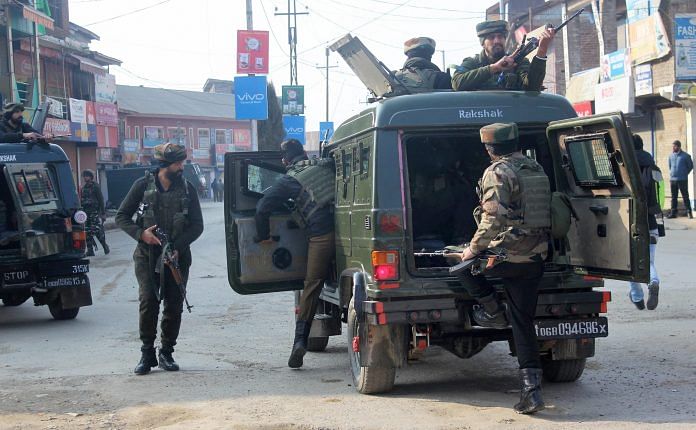It’s a common lament among Army officers — they bring the security situation under control, but political steps aren’t taken to capitalise on it.
In a press conference held in November, Lt. Gen. J.S. Sandhu, commander of 15 Corps responsible for operations in Kashmir, outlined the successes of the security strategy followed during 2017. While giving out figures for the number of terrorists killed in the hinterland, he said: “This has resulted in a remarkable change in situation.”
In a recent, well-articulated piece in The Indian Express titled ‘Across the Aisle: Revisiting Jammu and Kashmir’, P. Chidambaram again quoted figures of civilians, security forces and terrorists killed in 2017 to conclude that the current “hard, muscular and militarist approach of the government” had met with little success.
Both the Army and Chidambaram can bring strong arguments in favour of their respective positions, but J&K cannot be painted only in black and white.
There are no easy answers as to who is completely correct in his assessment. Gauging success in complex insurgencies and internal conflicts is an extremely difficult task. Which core metrics best define victory and enable us to assess the direction our strategy is taking is a question that most countries have struggled with.
Flawed assessments
Assessments based on limited, incomplete or out of context data can be flawed.
Now, 2016 was one of the worst years for Kashmir in recent times. However, the 2016 annual report of the Ministry of Home Affairs carried these remarks: “The year 2016 has seen a change in Pak tactics following a strategy of the superimposition of militancy over ‘civil resistance’ through radicalisation by vested interest groups and social media. In spite of this, the security situation continued to show improvement which has frustrated the evil designs of terrorist organisations and led them to target the security forces deployed in J&K.”
Because it is easier to comprehend, quantitative data tends to dominate our assessments. Therefore the number of terrorists killed becomes the prime parameter of our success, and the reduction in stone-pelting incidents is a measure of normalcy. Undoubtedly, there is value to this data, but by itself, it neither provides an accurate nor a holistic picture.
There are many-non quantifiable but important metrics – the sentiment of popular support for militants, social media activity, effectiveness of the government’s narrative, level of angst among the youth, political activity, and freedom to lead a normal life without being pulled out of your homes either by militants or soldiers. The meshing together of all this data to provide a realistic assessment is highly challenging process.
However, before they can even begin to define the metrics, organisations engaged in attempting to bring peace to J&K (and that includes all stakeholders, civil and military) should be clear about the overall objectives of the political leadership. This is absolutely essential for assessing success.
Leslie Gelb and Richard Betts, in an outstanding book, The Irony of Vietnam: The System Worked, wrote: “Administration leaders persistently failed to clarify US objectives in concrete and specific terms. Uncertainty and ambiguity in reports were therefore bound to emerge, for no one could be certain what he was measuring progress against or how victory could be defined.”
It is the absence of clear objectives that leads to a common lament among many military officers that the Army has on numerous occasions brought the security condition in J&K under control, but political steps have not been taken to capitalise on this. This does not reflect well on our ability to craft a common strategy or on the civil-military unity of effort required to combat internal conflicts. The military leadership can also not completely absolve itself of the blame as it has not always insisted on a well-defined set of aims from the political leadership.
Opportune time
As we enter 2018, it is perhaps an opportune time for the Ministry of Home Affairs to clearly lay down its objectives and aims, and provide strategic guidance to those responsible for executing the strategy on ground. I am not making any suggestions on the contours of an overall strategy to be adopted by the government. It is clearly for the current political leadership to decide. But their approach to ending violence and bringing peace to J&K should be coherently stated.
Thereafter, those working on ground, the Army in particular, can draw up the relevant metrics and provide credible assessments on whether the approach is succeeding or requires some course correction. The military leadership should utilise their expertise and experience in J&K to give honest advice, even if it sometimes carries a hint of disagreement.
There are no easy answers to finding a solution for J&K, but it is important to at least bring some clarity to the question of whether we are winning or losing.
The author retired as General Officer Commanding-in-Chief of the Indian army’s Northern Command







General, you have very succinctly summarized the situation in your last sentence. Now the key is to get the bureaucrats in the MHA to put objectives/targets into black and white -but why should the babu want to get evaluated against metrics when he has played the politician against the military against the separatists for decades and got away to plum post retirement berths. The sooner the military realizes its out there on the point on its own so much the better for it. A highly structured and disciplined force attuned to achievement of mission objective has been allowed to be misused by generations of COAS’s who have only dreams of Governorship in their gun sights.
The general has given the most contemporary and brilliant piece of suggestions for looking into this long complicated issue. It’s time to address